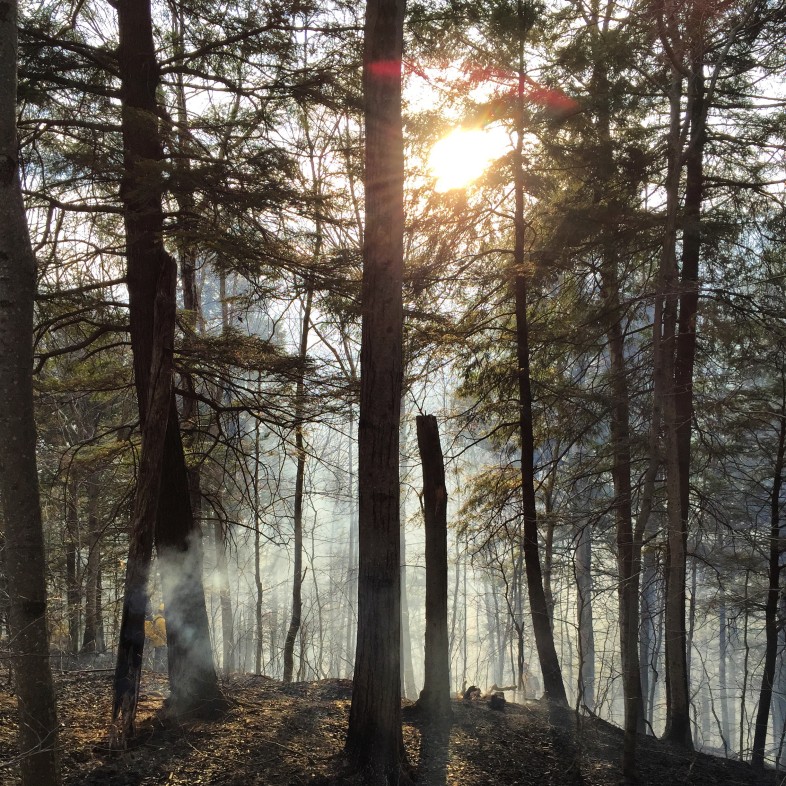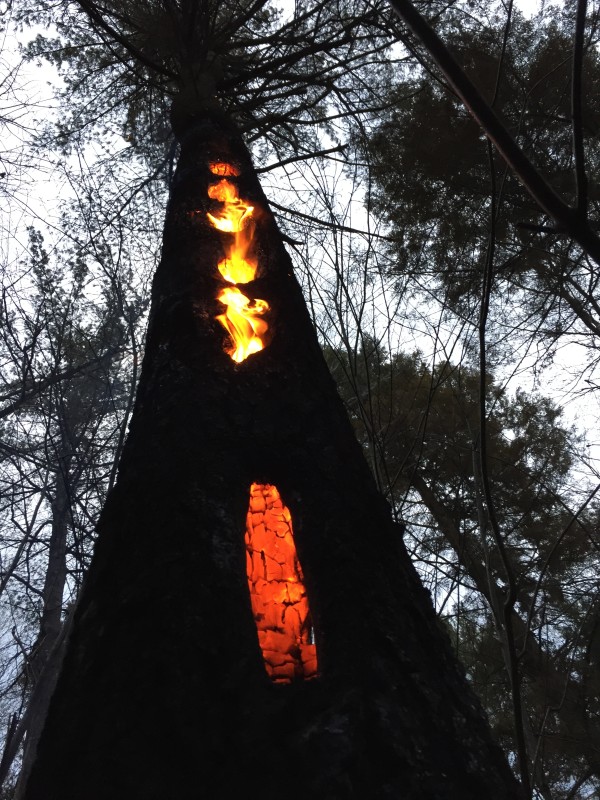
Smoke from a quick moving spring forest fire filters the setting sun. / © K.P. McFarland
We’re accustomed to images of wind-whipped flames roaring across a dry California hillside or torching a conifer forest in the Rocky Mountains. Conjure up a mental image of a wildfire, and its unlikely that the verdant hardwood forests of northern New England come to mind. With good reason, too; rarely are conditions in these forests suitable for sustaining fire. Most fires occur in the brief window between snowmelt and leaf-out, when humidity is relatively low and a season’s worth of fallen leaves have dried out in the early spring sun.
But fires in the northern hardwood forests are relatively rare, as evidenced by the fact that the forest is not fire-adapted like those in the southern or the western portion of the continent. Even in the southern New England hardwood forests, many of the trees, such as oak, hickory, and red maple, sprout vigorously from burned stumps and trunks after a fire. But the northern hardwood forest is comprised of more fire-sensitive species such as hemlock, beech, and sugar maple; anything more than a quick ground fire can kill a mature tree in the northern hardwood forest.
As if on cue, wildfires ignited around Vermont this spring. Several of our biologists are also volunteer firefighters, and while in the woods fighting wildfires, they’ve also got an eye on forest life.
Some Turkeys Can’t Fly
John Lloyd, VCE’s director of science, responded to a fire on Saturday afternoon in South Strafford, where he serves with the Strafford Fire Department. The fire burned across several acres of abandoned pasture now covered by second-growth forest and mats of common juniper before it was doused. While working to ensure that the fire was completely contained, he came across a Wild Turkey nest, which would have been well-hidden under the thick cover of juniper.
The sight of charred eggs lying in a pile of ash is a stark reminder of the power of fire and the need to exercise great caution in its use. In this case, though, the damage is largely transitory. The heat of the fire killed the embryonic turkeys contained within those eggs, but the female – who he presume escaped ahead of the flames – will almost surely build another nest and lay another clutch of eggs within days. Those eggs, barring an exceptionally dry spring, will face no threat from fire.

A WIld Turkey nest lost to a rare spring wildfire. / © John Lloyd
Fire in the Hole
A few days ago Kent McFarland, a senior research biologist at VCE and a volunteer for Woodstock Fire Department, was extinguishing hotspots on a large forest fire near the Appalachian Trail in Norwich. The remaining hotspots tended to be small piles of downed trees or old snags and hollowed sugar maples tapped long ago. But one tree stood out in the fading evening light.
Hollow but still alive, an Eastern White Pine tree glowed from within. The hollow trunk funneled fire upward and holes, carved by Pileated Woodpeckers exploring for food in the rotting tree, glowed orange with fire with flames licking out of some of them.

Feeding holes from Pileated Woodpeckers shine bright with fire. /© KP McFarland
How often do forest fires naturally roll through a typical northern hardwood forest?
Researchers from the Harvard Forest in Petersham, Massachusetts, studied ancient charcoal and pollen to find the answer. The scientists sampled four lakes in northern hardwood forests using a tool that sinks into the sediment and retrieves a solid core. Each layer of sediment was examined for microscopic fossil charcoal and pollen. Ages of each layer were determined using radiocarbon dating, with the timing of European settlement noted by decreases in the amount of tree pollen and increases in pollen from plants such as ragweed and grasses that were rare or absent before.
Comparing the northern hardwood forest cores to those from other New England forests showed that fire is quite rare in northern hardwood forests, with a given area being burned only once every 1,000 years or more prior to European settlement. Our cool, moist northern hardwoods are not easily ignited. When they do burn, it is usually a light burn through the relatively moist leaf litter.
Three of the sites had significant increases in charcoal after European settlement, ranging from a 5- to 10-fold increase between pre-settlement and post-settlement times. In fact, today, over 95 percent of all forest fires locally are caused by human activity.
We often hear that Native Americans burned large tracts of forest regularly In New England. In 1632, Thomas Morton, living near Boston, famously wrote, “The Savages are accustomed, to set fire of the Country in all places where they come; and to burne it, twize a year, vixe at the Springe, and the fall of the leafe.” However, that was in southern New England, close to the coast. There is little evidence that fire was ever used frequently, if at all, in our local northern hardwood forests, where Native American populations were much lower.
Evidence of fire can be found in a forest for many years afterward, and some clues are relatively easy to identify. Hot, slow fires leave two obvious signs: basal trunk scars and multiple-trunked trees. But be careful – so may past logging operations. With a fire, basal scars will be more randomly distributed than logging scars in flat areas or, on hillsides, will be found only on the uphill side of the trunk. Why only on the uphill side? Think about leaf litter and gravity; the leaves and twigs slide slowly down the slope only to be stopped by a tree trunk, where they gather like water behind a dam. As fire passes and wraps around the trunk, it encounters the deeper leaf litter, which burns slower and hotter than the thin cover below the trunk, biting through the bark of the tree and leaving a triangular scar.
Finding charcoal as a clue to a past forest fire is much more difficult. Charcoal breaks down and is generally not visible after just a few years. Dead wood, especially beech and maple, often has a smooth, black coating that has the appearance of being charred but isn’t. This is actually a fungus and is part of the natural decaying process. But it’s still worth a try to find evidence of one of our local forests’ rarer phenomena.

Interesting post, hours after the last embers were cool; great photos. Thanks!
Why were so many fire-towers built on Vt mountains? When were they last manned?
Louise – great questions! And these articles from the Center for Northern Woodlands Education should have the answers you seek:
https://northernwoodlands.org/articles/article/fire-towers-in-the-northeast
https://northernwoodlands.org/outside_story/article/where-have-all-the-fires-gone